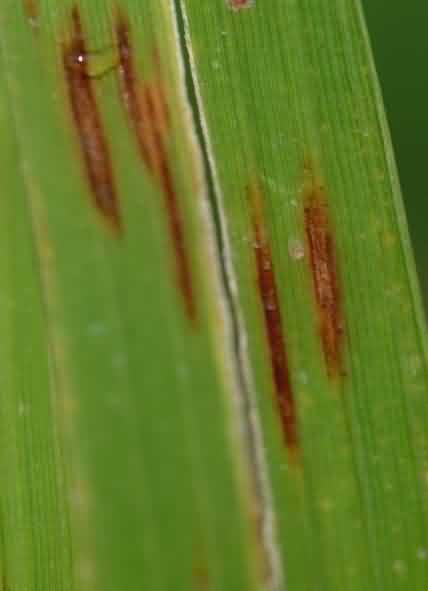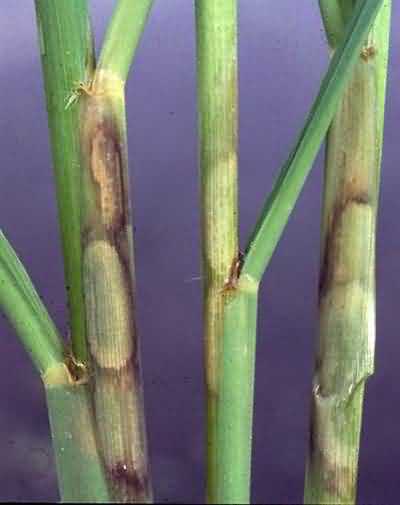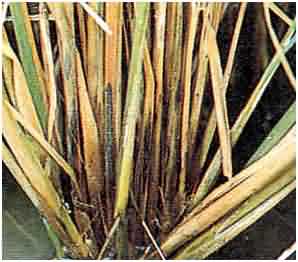चावल के 5 प्रमुख रोग (ओरीज़ा सतवा)
1. Rice Blast
Causal Organism -Pyricularia oryzae (Syn: P. grisea) (Sexual stage: Magnaporthe grisea)
Symptom- On the leaves, the lesions start as small water soaked bluish green specks, soon enlarge and form characteristic boat shaped spots with grey centre and dark brown margin.
The spots join together as the disease progresses and large areas of the leaves dry up and wither. Similar spots are also formed on the sheath.
Severely infected nursery and field show a burnt appearance.
At the flower emergence, the fungus attacks the peduncle which is engirdled, and the lesion turns to brownish-black. This stage of infection is commonly referred to as rotten neck / neck rot / neck blast / panicle blast.
In early neck infection, grain filling does not occur and the panicle remains erect like a dead heart caused by a stem borer. In the late infection, partial grain filling occurs. Small brown to black spots also may be observed on glumes of the heavily infected panicles.
Management
- Use of seeds from a disease free crop
- Grow resistant varieties like MTU 1010, Swathi, IR 64, IR 36, Jaya, Vijaya, Ratna,
- Remove and destroy the weed hosts in the field bunds and channels.
- Split application of nitrogen and judicious application of nitrogenous fertilizers
- Treat the seeds with Captan or Thiram or Carbendazim or Carboxin or Tricyclazole at 2 g/kg.
- Seed treatment with biocontrol agent Trichoderma viride@ 4g/kg or Pseudomonas fluorescens @ 10g/kg of seed.
- Avoid close spacing of seedlings in the main field.
- Spray the main field with
This email address is being protected from spambots. You need JavaScript enabled to view it. %.
2. Brown Spot of Rice
Causal Organism- Helminthosporium oryzae (Syn: Drechslera oryzae) (Sexual stage: Cochliobolus miyabeanus)
Symptom - Symptoms appear as lesions (spots) on the coleoptile, leaf blade, leaf sheath, and glumes, being most prominent on the leaf blade and glumes.
The disease appears first as minute brown dots, later becoming cylindrical or oval to circular. The several spots coalesce and the leaf dries up.
The seedlings die and affected nurseries can often be recognized from a distance by their brownish scorched appearance.
Management
- Use disease free seeds.
- Field sanitation-removal of collateral hosts and infected debris in the field.
- Crop rotation,
- Adjustment of planting time
- Balance dose of nitrogenous fertilizer.
- Treat the seeds with Thiram or Captan at 4 g/kg and with Mancozeb @0.3%
- Spray the crop in the main field twice with Mancozeb@0.2%, once after flowering and second spray at milky stage.
3. Sheath blight of Rice
Causal Organism- Rhizoctonia solani (Sexual stage: Thanetophorus cucumeris)
Symptom - Initial symptoms of sheath blight are noticed on leaf sheaths near water level. On the leaf sheath oval or elliptical or irregular greenish grey spots are formed.
As the spots enlarge, the centre becomes greyish white with an irregular blackish brown or purple brown border.
Lesions on the upper parts of plants extend rapidly coalescing with each other to cover entire tillers from the water line to the flag leaf.
The presence of several large lesions on a leaf sheath usually causes death of the whole leaf, and in severe cases all the leaves of a plant may be blighted in this way. The infection extends to the inner sheaths resulting in death of the entire plant.
Older plants are highly susceptible. Five to six week old leaf sheaths are highly susceptible.
Plants heavily infected in the early heading and grain filling growth stages produce poorly filled grain, especially in the lower part of the panicle.
Management
- Avoid excess doses of fertilizers.
- Eliminate weed hosts.
- Avoid flow of irrigation water from infected fields to healthy fields.
- Deep ploughing in summer and burning of stubbles.
- Spray Propiconazole@0.1% or Hexaconazole@0.2% or Validamycin@0.2%
- Seed treatment with Pseudomonas fluorescens @ of 10g/kg of seed followed by seedling dip @ of 2.5 kg of product/ha dissolved in 100 litres and dipping for 30 minutes.
- Soil application of P.fluorescens @ of 2.5 kg/ha after 30 days of transplanting (This product should be mixed with 50 kg of FYM/Sand and then applied.
4. Bacterial leaf blight
Causal Organism- Xanthomonas oryzae pv. Oryzae
Symptom- The bacterium induces either wilting of plants or leaf blight. Wilt syndrome known as Kresek is seen in seedlings within 3-4 weeks after transplanting of the crop.
Kresek results either in the death of whole plant or wilting of only a few leaves. The bacterium enters through the hydathodes and cut wounds in the leaf tips, becomes systemic and cause death of entire seedling.
The disease is usually noticed at the time of heading but in severe cases occur earlier also. In grown up plants water soaked, translucent lesions appear usually near the leaf margin.
The lesions enlarge both in length and width with a wavy margin and turn straw yellow within a few days, covering the entire leaf. As the disease progresses, the lesions cover the entire leaf blade which may turn white or straw coloured.
Lesions may also be seen on leaf sheaths in susceptible varieties. Milky or opaque dew drops containing bacterial masses are formed on young lesions in the early morning. They dry up on the surface leaving a white encrustation.
The affected grains have discolored spots surrounded by water soaked areas. If the cut end of leaf is dipped in water, bacterial ooze makes the water turbid.
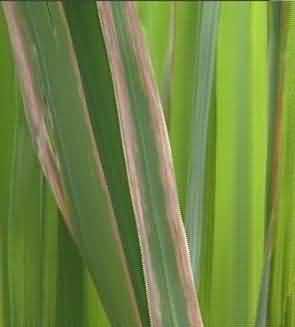
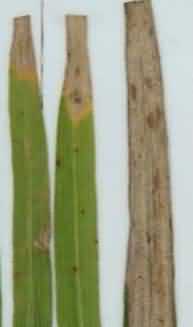
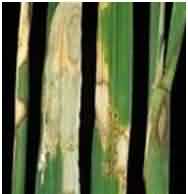
Management
- Grow resistant cultivars like MTU 9992, Swarna, Ajaya, IR 20, IR 42, IR 50.
- Affected stubbles are to be destroyed by burning or through ploughing.
- Judicious use of nitrogenous fertilizers.
- Remove and destroy weed hosts.
- Soaking seeds for 8 hrs in Agrimycin (0.025%) followed by hot water treatment for 10 minutes at 52-54 0C eradicates the bacterium in the seed.
- Spray Streptocycline (250 ppm) along with copper oxychloride (0.3%).
5. Sheath rot of Rice
Causal organism- Sclerotium oryzae (Sexual stage: Leptosphaeria salvinii)
Symptoms- Small black lesions are formed on the outer leaf sheath near the water line and they enlarge and reach the inner leaf sheath also. The affected tissues rot and abundant sclerotia are seen in the rotting tissues.
The culm collapses and plants lodge. If the diseased tiller is opened, profuse mycelial growth and large number of sclerotia can be seen. The sclerotia may be seen in the stubbles after harvest.
Management
- Use recommended doses of fertilizer.
- Deep ploughing in summer and burning of stubbles and infected straw
- Draining off the irrigation water and allow the soil to dry
- Avoid flow of irrigation water from infected fields to healthy fields.
Authors:
SHARAD SHROFF
Assistant Professor (Plant Pathology)
RMD College of Agriculture and Research Station, Ambikapur (C.G) IGKV Raipur (C.G)
Email:





